Having a website that not only looks good but also performs exceptionally is crucial for businesses. One of the most effective ways to refine your website design and boost user engagement is through A/B testing. This powerful tool allows you to make data-driven decisions that can lead to increased conversions and a better user experience.
What is A/B Testing?
A/B testing, also known as split testing, is a method of comparing two versions of a webpage or design element to determine which one performs better. By presenting Version A to one group of users and Version B to another, you can analyze which version yields higher engagement, conversions, or other desired actions.
Benefits of A/B Testing in Web Design
- Improved User Experience: By testing different design elements, you can discover what resonates best with your audience, making your website more user-friendly.
- Increased Conversion Rates: Small changes, like the color of a button or the wording of a call-to-action, can significantly impact conversion rates.
- Data-Driven Decisions: A/B testing provides concrete data, allowing you to make informed decisions rather than relying on assumptions.
How to Implement A/B Testing on Your Website
- Identify Elements to Test: Common elements include headlines, images, call-to-action buttons, and layout structures.
- Set Clear Goals: Determine what you want to achieve with the test, such as increased sign-ups, clicks, or time spent on the page.
- Analyze the Results: After running the test for a sufficient period, analyze the data to see which version performed better.
- Implement the Winning Version: Apply the successful elements to your website to optimize performance.
Real-World Example
- Identify Elements to Test: Common elements include headlines, images, call-to-action buttons, and layout structures.
- Set Clear Goals: Determine what you want to achieve with the test, such as increased sign-ups, clicks, or time spent on the page.
- Analyze the Results: After running the test for a sufficient period, analyze the data to see which version performed better.
- Implement the Winning Version: Apply the successful elements to your website to optimize performance.
Real-World Example
Imagine you’re unsure whether a red or green call-to-action button will encourage more visitors to sign up for your newsletter. By conducting an A/B test, you might discover that the green button results in a 15% higher sign-up rate, guiding you to make that change permanently.
Best Practices for A/B Testing
- Test One Element at a Time: To accurately determine what’s influencing user behavior, isolate individual variables.
- Ensure Statistical Significance: Run the test long enough to collect sufficient data for reliable results.
- Keep Testing: User preferences can change over time, so continuous testing helps keep your website optimized.
Conclusion
A/B testing is an invaluable strategy for any business looking to enhance their website design and performance. By embracing this method, your website can stay ahead of the competition, ensuring their websites meet the evolving needs of their audience. Start experimenting with A/B testing today, and watch your website transform into a more effective tool for your business growth.
To read more tips on web design strategies, check out our other web design articles. If you’re interested in partnering with STORY to optimize your current marketing efforts, visit our website to learn more about our services.
